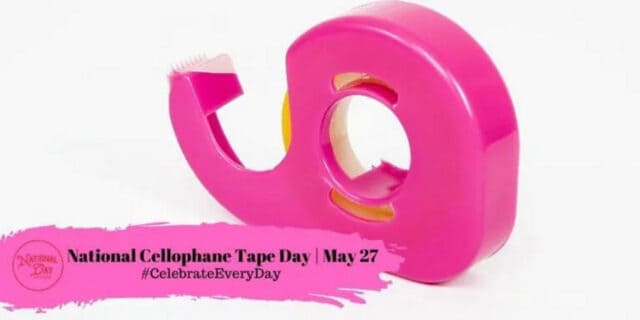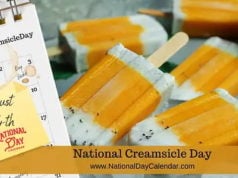
It could be a sticky situation on May 27th as we recognize National Cellophane Tape Day. It is hard to imagine where we would be without this invention. How would we wrap our Christmas and birthday gifts?
This everyday household and office item is also known as invisible tape or Scotch Tape.
- Richard Gurley Drew invented the invisible tape in 1930. He created the tape from cellulose and originally called it cellulose tape.
- His career started at the 3M company in 1920 in St. Paul, Minnesota where he developed a masking tape for the automotive industry in 1925.
- Originally designed to seal Cellophane packages sold in groceries and bakeries, the new adhesive missed its mark. By the time all its drawbacks were resolved, DuPont introduced heat-sealed cellophane.
- Regardless, with a resounding endorsement from customers, 3M found a market in both the home and the office.
- The first brand of cellophane tape was developed by Richard Drew, and was called “Scotch” tape and now bears a very recognizable trademark of a red, black, and green tartan pattern.
- The name Scotch Tape actually resulted from an ethnic slur foisted upon manufacturers of the tape—although the product does not have any connection with Scotland or the Scottish.
- The term came about when a body shop painter who was testing one of the first tapes and announced in frustration “Take this tape back to those Scotch bosses of yours and tell them to put more adhesive on it!” Scotch at the time being a slang term for ‘stingy’.
- Drew also invented the first masking tape in 1925—a 2-inch-wide tan paper tape with a pressure-sensitive adhesive backing.
- It was invented for military purposes. Before the invention of adhesive tape, boxes with cartridges that were sent to military bases were sealed with wax. This was done in order to keep their contents watertight. The cardboard flaps were glued together by a paper strip, the end of which was hanging so that the soldiers in a hurry could open the box.
- It helped save the team of “Apollo 13”. After the explosion of the service module on board the ship “Apollo 13” three crew members were subjected to mortal danger. NASA engineers decided to save the crew from the carbon dioxide that was rapidly spreading inside the ship with the help of non-standard manipulation. From the cardboard, plastic bags and tape, a spacesuit was built, serving as a filter for carbon dioxide. This decision ultimately saved the lives of astronauts. Since then, the adhesive tape has become an indispensable assistant in the force majeure situations of space expeditions.
- Since 2005, the town of Avon, Ohio, hosts the annual festival of adhesive tape. There you can take part in a parade, fashion show, see sculptures and just have fun.
- John A Borden, another 3M engineer, invented the first tape dispenser with a built-in cutter blade in 1932. Scotch Brand Magic Transparent Tape was invented in 1961, an almost invisible tape that never discolored and could be written on.
- In 1953, Soviet scientists showed that triboluminescence caused by peeling a roll of an unidentified Scotch brand tape in a vacuum can produce X-rays. In 2008, American scientists performed an experiment that showed the rays can be strong enough to leave an X-ray image of a finger on photographic paper.
- Ornithologists have used Scotch Tape to cover cracks in the soft shells of fertilized pigeon eggs, allowing the eggs to hatch.
- During the Depression, banks first used Scotch Tape to mend torn currency
- Scotch Tape has been used as an anti-corrosive shield on the Goodyear Blimp.
- 1932: Scotch® Brand introduces the first heavy-duty, countertop tape dispenser. It’s made from cast iron and weighs almost 7 pounds.
- 1939: Scotch® Brand welcomes the “snail,”—its iconic, handheld tape dispenser. The first version is made from stamped sheet metal, and a molded plastic model is added one year later.
- 1941 – 1945: During World War II, almost all tape production is diverted to the war effort. 3M develops and manufactures more that 100 different types of tape to help solve war production problems such as sealing, identifying parts, holding materials, protecting and insulating. Scotch® Double-Sided Tape, coated with adhesive on both sides, joins the transparent tape family during this time.
- 1961: 3M invents Scotch® Magic™ Tape. The innovative matte-finish tape is virtually invisible on light-colored paper and envelopes. Unlike glossy tapes, it can be written on with pen, pencil or marker. At about the same time, Scotch® Cellophane Tape is renamed Transparent Tape.
- 2013: Scotch® Brand designers also reimagined the iconic “snail” dispenser for the first time in 60 years. The new dispenser features a modernized, sophisticated shape that conforms to the hand, improving comfort and ease of use.
Sources












